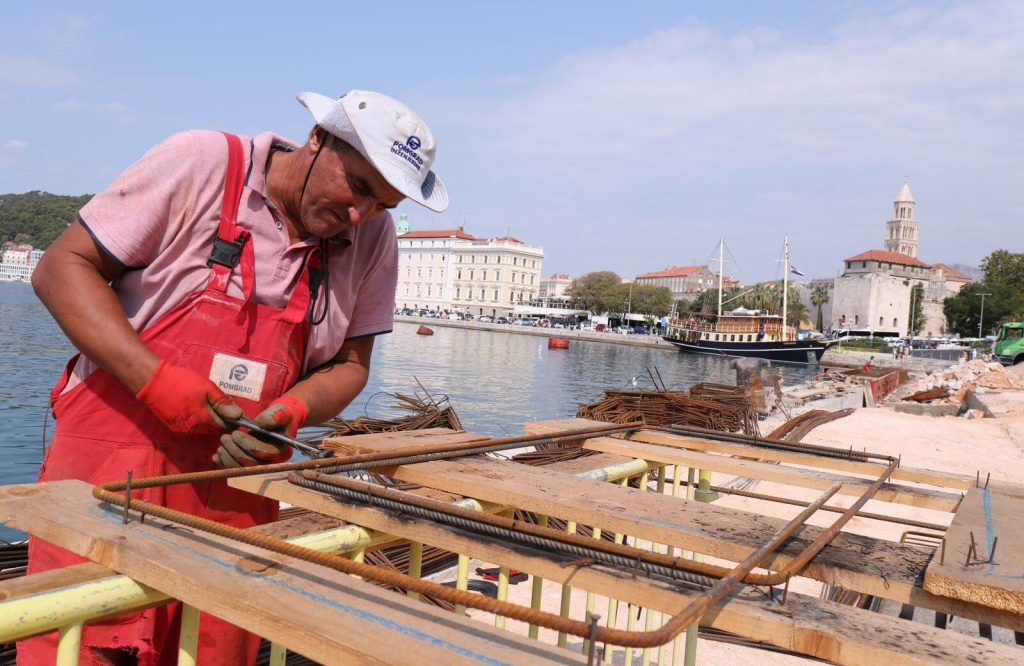“The works are progressing well. The first part of the coast is in the phase of laying stones, the second part of concreting is underway, installations are being carried out, followed by communal equipment. We hope that, if there are no major weather conditions, the works will be completed by the end of the year,” said the director of the Port Authority, Vice Mihanović for Dalmacija Danas.
Most of the money comes from EU funds, while a small part will be financed from the state budget.
“The value of the works is 42 million kuna, co-financed from EU funds, and the rest from the state budget. Therefore, the whole East Coast project will not cost a single kuna from the Port Authority, the City, or the County. In my opinion, this is the right direction in which to work – preparation is important, we should constantly work on resolving property-legal relations, on project documentation, to somehow meet all the needs and conditions for applying for European money,” says Mihanović.
Nothing was done on the East Coast for a long time. But, every year, as more and more tourists pass through the city of Split, it is time for things to move.
“The coast is being rebuilt after 150 years. It was built during the Austro-Hungarian Empire when the notch of the railway was dug, and the excess material was poured. This time lag speaks volumes about how much it was needed because in 150 years, our city and port have experienced a big step forward and expansion, and therefore the needs are greater. What makes me happy, apart from the operational part and the operational needs of the port, the city of Split and the citizens of Split will get a beautiful, modern promenade paved with stone. The project is adapted for people with disabilities, so the operational part is separated from walking. The width will be nine and a half meters; the length is 260. I hope that this is the beginning of arranging the entire East Coast and surroundings,” explained Mihanović.
In addition to the new promenade, there will be new berths.
“We will get four berths for high-speed lines or catamarans. We assessed this as necessary because this type of maritime transport has increased by 60 percent and is by far the fastest-growing type of maritime transport. This is the result of changes in travel habits because we want to get from point A to point B as soon as possible,” Mihanović continued.
And the only thing left to solve is the biggest problem of the port of Split, which is one-way traffic that was supposed to relieve the port. Namely, the Jadran Bridge cannot withstand heavy traffic.
“It is not within the competence of the Port Authority, but it indirectly affects us as well. Unfortunately, we witnessed that people could not get out of the city port for two hours last summer. We could have done that at one point; we even shared water for free with those passengers, no longer knowing how to help them. As a city councilor and politician, I presented the solution for constructing a new two-lane exit from the city port, which would start from the Prince Domagoj Coast, be a 70-meter-long tunnel, and exit at Mihovil Pavlinović Square, i.e., at the beginning of Bijankinijeva. This would bypass the part of the Jadran Bridge where the traffic is one-lane, and the entire length of such a solution would be two-lane.
The Faculty of Civil Engineering did the traffic simulation in Split, and one-third of the conceptual design was paid by the Port Authority, one-third by the City of Split, one-third by Hrvatska cesta. This simulation showed that such a solution meets current needs. This is the fastest thing that can be done, and now it is the turn of the City of Split. I called the mayor to accept my proposal because it is the turn of the City of Split. The first step needs to be taken, and that is the changes to the GUP. I am the president of the commission for urbanism; on that commission, the representatives of the political option of the mayor and deputy Ivošević were against the inclusion of the exit from the city port in the changes to the GUP that follow us. They were outvoted because there was common sense in other political options, and it was unanimously adopted at the last session of the GV. It is now up to the City to start changes to the GUP as soon as possible, which is an essential precondition for Croatian Roads to obtain a building permit and realize that solution.
What is essential with this proposal is that the deadlines are 12 months for execution, and the property-legal relationship has been entirely resolved, i.e., all plots through which the road passes are owned by either Croatian Railways or Croatian Roads or the City of Split,” he concluded.
For more, make sure to check out our dedicated lifestyle section.








